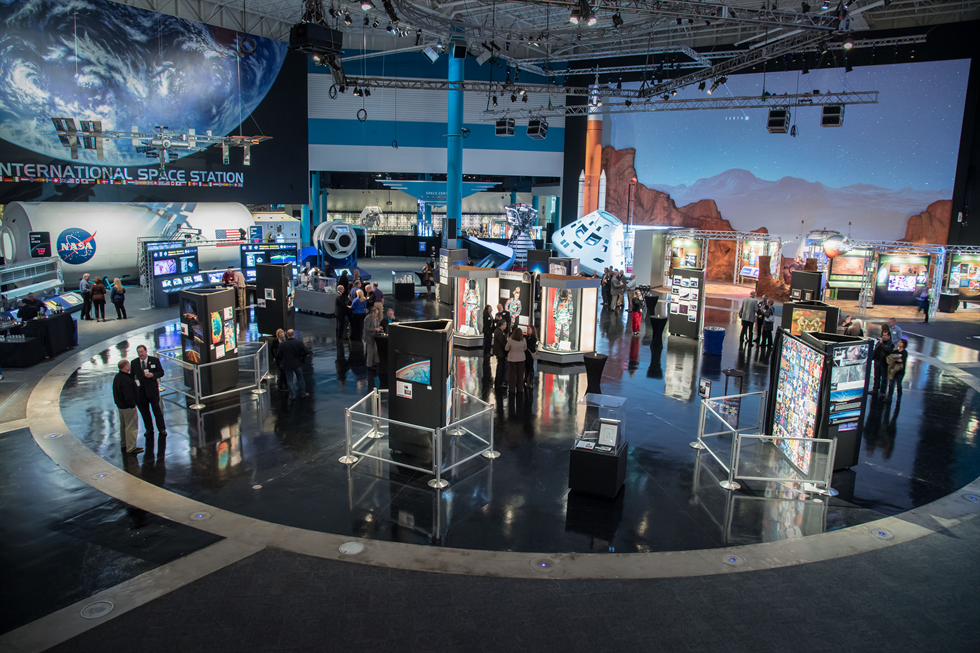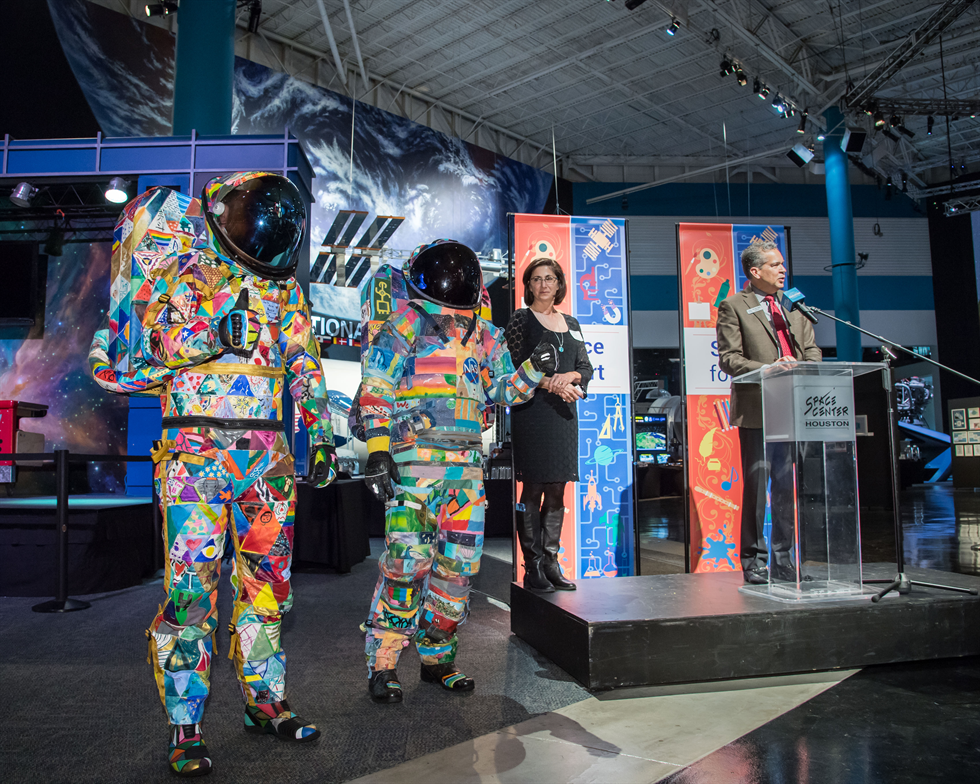Art and STEM: Unlikely accomplices in the quest for innovation
2017-03-14
Known for its workforce of “rocket scientists” who demonstrate immense technical aptitude while catapulting humankind regularly into the cosmos, one might find it surprising that NASA Johnson Space Center also boasts some of the most well-rounded professionals. Could it be that a workforce dedicated to furthering traditional science, technology, engineering and math (STEM) fields also has room in its collective gray matter for art? Studies show that answer is: Yes.
Retired astronaut Nicole Stott, also the first person to paint while in space, wanted to unveil these hidden talents with an exhibit at Space Center Houston called Space for Art. The exhibit runs until March 19 and showcases artists among the JSC team, as well as the spacesuits Hope and Unity of Spacesuit Art Project fame. Those colorful suits, painstakingly stitched together by spacesuit manufacturer ILC Dover, are comprised of mini fabric masterpieces painted by cancer patients in Houston and around the world.
“My whole motivation in pulling that exhibit together was based on my experience of 28 years with NASA, where everyone is primarily thought of as the scientist, engineer or astronaut,” Stott said. She mentioned that while encountering JSC team members along the way, “there’s this little secret that they have where they’re this wonderful painter, musician, quilter, skateboard maker, woodworker, stained-glass artist or cake maker—all these things. I don’t know why I started doing it, but I kept this list over time [of] people [who] have something artistic going on.”
Stott was ecstatic when she received the green light from Space Center Houston to host the exhibit, allowing the greater public to see that it would not be wise to stereotype Johnson’s STEM professionals as left-brained, robotic thinkers.
“One of the coolest things was watching somebody like Ginger Kerrick, who’s helped train us, was the first non-astronaut CAPCOM and is now flight director and running a big part of the show in the Flight Operations Directorate, encounter Bob Tweedy, one of our countermeasures guys, as they came in with their artwork,” Stott said. “And they’re looking at each other … and they’ve known each other 15, 20 years … and they’re like, ‘What are you doing here?’”
To which the other replied, “What are you doing here?”
“And here’s Ginger’s sculptural cake that she’s done, and Bob’s handcrafted longboard skateboard, made out of inlaid wood, and they’re looking at each other like, I never had a clue,” Stott continued. “For them to be able to meet each other again on a totally different level, I think it’ll translate very nicely to the work that they’re going to be doing. There’s that duality—it’s not either/or.”
For Tweedy, a Countermeasures System instructor, his art was born of something he has a penchant for: problem solving.
“The idea to build longboards came to me when I was trying to figure out what I was going to do with a bunch of scrap wood I had accumulated,” Tweedy said. “So I just repurposed the scraps.”
Art and STEM should not be seen as strange bedfellows, in Tweedy’s opinion.
“STEM and art are closely related; each is an exercise in problem solving,” Tweedy said. “Both are environments which force you to learn specific skills and techniques in order to create a piece or a system that functions correctly. It’s extremely satisfying to combine the aesthetic and conceptual details of art with the analytical applications of the engineering world to make something cool.”
Art only diverges from human space exploration when the universe forces its cold calculations upon engineers.
“NASA engineers need to create hardware that not only functions correctly, but they also must make this happen with the constraints only found in the microgravity environment,” Tweedy said.
Universe: 1. Art: 0.
However … “You can only do so much with ones and zeroes,” Stott said of binary code. “So whether it’s a picture or a video or music that communicates a complex concept better to us, it comes down to that creative, artistic medium to do it.”
Stott hopes Space for Art engages the public with NASA’s human space exploration story and encourages educators and administrators to be less exclusionary with curriculum.
“You really don’t have to choose,” Stott said. “Even at elementary school, they’re already trying to pigeonhole you down the science or humanities side. But I want my son using his whole brain. I want him to really think creatively about problem solving and how he deals with people, and I think this is an example of how that happens.”
Visit Space Center Houston to see Space for Art before it launches to its next destination.
Catherine Ragin Williams
NASA Johnson Space Center
Retired astronaut Nicole Stott, also the first person to paint while in space, wanted to unveil these hidden talents with an exhibit at Space Center Houston called Space for Art. The exhibit runs until March 19 and showcases artists among the JSC team, as well as the spacesuits Hope and Unity of Spacesuit Art Project fame. Those colorful suits, painstakingly stitched together by spacesuit manufacturer ILC Dover, are comprised of mini fabric masterpieces painted by cancer patients in Houston and around the world.
“My whole motivation in pulling that exhibit together was based on my experience of 28 years with NASA, where everyone is primarily thought of as the scientist, engineer or astronaut,” Stott said. She mentioned that while encountering JSC team members along the way, “there’s this little secret that they have where they’re this wonderful painter, musician, quilter, skateboard maker, woodworker, stained-glass artist or cake maker—all these things. I don’t know why I started doing it, but I kept this list over time [of] people [who] have something artistic going on.”
Stott was ecstatic when she received the green light from Space Center Houston to host the exhibit, allowing the greater public to see that it would not be wise to stereotype Johnson’s STEM professionals as left-brained, robotic thinkers.
“One of the coolest things was watching somebody like Ginger Kerrick, who’s helped train us, was the first non-astronaut CAPCOM and is now flight director and running a big part of the show in the Flight Operations Directorate, encounter Bob Tweedy, one of our countermeasures guys, as they came in with their artwork,” Stott said. “And they’re looking at each other … and they’ve known each other 15, 20 years … and they’re like, ‘What are you doing here?’”
To which the other replied, “What are you doing here?”
“And here’s Ginger’s sculptural cake that she’s done, and Bob’s handcrafted longboard skateboard, made out of inlaid wood, and they’re looking at each other like, I never had a clue,” Stott continued. “For them to be able to meet each other again on a totally different level, I think it’ll translate very nicely to the work that they’re going to be doing. There’s that duality—it’s not either/or.”
For Tweedy, a Countermeasures System instructor, his art was born of something he has a penchant for: problem solving.
“The idea to build longboards came to me when I was trying to figure out what I was going to do with a bunch of scrap wood I had accumulated,” Tweedy said. “So I just repurposed the scraps.”
Art and STEM should not be seen as strange bedfellows, in Tweedy’s opinion.
“STEM and art are closely related; each is an exercise in problem solving,” Tweedy said. “Both are environments which force you to learn specific skills and techniques in order to create a piece or a system that functions correctly. It’s extremely satisfying to combine the aesthetic and conceptual details of art with the analytical applications of the engineering world to make something cool.”
Art only diverges from human space exploration when the universe forces its cold calculations upon engineers.
“NASA engineers need to create hardware that not only functions correctly, but they also must make this happen with the constraints only found in the microgravity environment,” Tweedy said.
Universe: 1. Art: 0.
However … “You can only do so much with ones and zeroes,” Stott said of binary code. “So whether it’s a picture or a video or music that communicates a complex concept better to us, it comes down to that creative, artistic medium to do it.”
Stott hopes Space for Art engages the public with NASA’s human space exploration story and encourages educators and administrators to be less exclusionary with curriculum.
“You really don’t have to choose,” Stott said. “Even at elementary school, they’re already trying to pigeonhole you down the science or humanities side. But I want my son using his whole brain. I want him to really think creatively about problem solving and how he deals with people, and I think this is an example of how that happens.”
Visit Space Center Houston to see Space for Art before it launches to its next destination.
Catherine Ragin Williams
NASA Johnson Space Center

The Space for Art gallery opening on Jan. 26 at Space Center Houston. Image Credit: NASA/Bill Stafford

Spacesuits Hope and Unity make a colorful entrance while William T. Harris, president of Space Center Houston, speaks at the podium. With him is the mastermind behind the exhibit concept, retired astronaut Nicole Stott. Image Credit: NASA/Bill Stafford

JSC Director Ellen Ochoa poses with her flute, showing her own artistic bent. Image Credit: NASA/Bill Stafford

Children are entranced by the out-of-this-world quilts that began as a 9-inch square completed in space by astronaut Karen Nyberg. Image Credit: NASA/Bill Stafford







